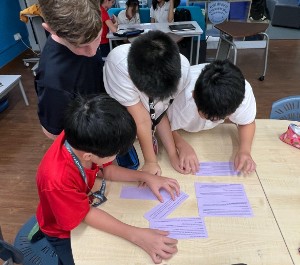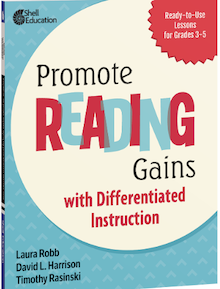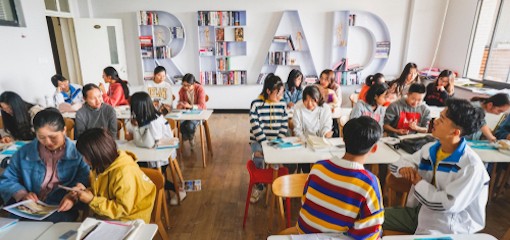Differentiate with the Station Rotation Model
By Dr. Laura Robb
 The first time I met with Ms. Williams (pseudonym), I felt her frustration throughout most of our hour together. Her class of twenty-eight fifth graders included ten students reading two to three years below grade level, twelve students reading on grade level and six reading about a year above grade level.
The first time I met with Ms. Williams (pseudonym), I felt her frustration throughout most of our hour together. Her class of twenty-eight fifth graders included ten students reading two to three years below grade level, twelve students reading on grade level and six reading about a year above grade level.
Required to teach four novels, one each semester, Ms. Williams felt frustrated because she had so many students who couldn’t read the novel and use it to practice inferring to find characters’ personality traits.
Ms. Williams had two challenges to resolve:
(1) How to support students who weren’t learning to infer personality traits.
(2) Figure out what students who weren’t working with her would do in the interim.
Here’s how Ms. Williams differentiated instruction to deepen the twelve students’ understanding of inferring personality traits. First, she divided the twelve students into three groups of four and worked with each group for fifteen minutes for two consecutive days using easy texts from a basal reader at the students’ instructional reading levels.
While she worked with one group, the rest of the class first completed a notebook entry on the read-aloud picture book Ms. Williams recently finished, Each Kindness by Jacqueline Woodson, and they used the remaining time to read their self-selected books. However, students had too much time to work independently, and by the end of about 25 minutres, questions and conversations began to detract from teacher-supported small group learning.
Ms. Williams’ goal of engaging both groups of students in meaningful learning wasn’t working. At our next meeting we discussed another way to differentiate students’ learning: the station rotation model.
Differentiated Learning Stations
Setting up stations to prepare students for an upcoming unit or topic – or to provide re-teaching, support, and enrichment after completing a unit of study – is an excellent way to meet the needs of each student in your class.
Mix up the membership of stations by having one for individual work, one where students collaborate with a small group, one for partner work, and one for working with you.
Developing differentiated learning stations requires much thought and planning by you so that the tasks and choices offered students are meaningful and will engage and motivate them to do their best work. It’s beneficial to start small, develop one set of stations students will rotate through, and then reserve time to evaluate what worked well and what you could improve. Since station learning is student-centered, it’s important to gather feedback from students. Here are some tips for organizing station learning:
• Build background knowledge and vocabulary before starting a unit.
• Bring depth to a specific topic in a unit.
• Use formative assessments and students’ feedback to design stations that re-teach, support, and enrich during or after completing a unit.
To Grade or Not to Grade
Avoid grading all the work students complete from stations. Offer feedback to the entire class and to individuals with the goal of improving students’ thinking, understanding, and writing, Work in stations is often extra practice or preparation for a unit. Grading every station can remove students’ pleasure in learning and exploring new ideas and information.
Ms. Williams and I agreed that stations she would develop would be ungraded and meet the needs of two groups in her class: the group needing extra practice with inferring personality traits, and the second group that would learn about and practice drawing conclusions.
Developing Station Rotation Lessons
Here are the goals and procedures Ms. Williams developed for her students’ first station rotation learning experience:

Then she wanted time with students for modeling and practicing inferring personality traits. To vary students’ tasks, she included watching videos and reading short, accessible texts.
She also recognized that to create effective and engaging stations she had to pre-plan and think though the contents of each one, and that’s why she created two sets of stations that ran simultaneously: one for students who needed support and the other to enrich students capable of moving forward. Her pre-planning notes enabled her to make the following decisions:
► She used 45 minutes of her 90-minute block for stations that each lasted 15 minutes. Students received a two-minute warning before time was up and put completed work in a tray and incomplete work in a folder. They could finish incomplete work during independent reading.
► She transitioned students to the next station by having them stand, do a few stretches, and then retrieve materials.
► She had clear directions available to students at each station. She reviewed these directions before students started completing station work.
► She noted, on the white board, lists of partners for each set of stations.
► She had students bring their computers and a pencil to work in stations one and two.
Prior to planning the content of each station, Ms. Williams developed objectives that determined the content and what individuals, pairs, or small groups would do, as well as how she would arrange the desks (or tables) in the room. Station materials were on two half-round tables and clearly labeled.
Ms. Williams formed a “U” with twelve desks and organized the remaining desks into four groups at the opposite side of the room. If students worked in pairs or groups at a specific station, then she listed these names on a whiteboard before students started.
Fifth Grade Stations: Inferring Personality Traits
Objectives of stations: All students watched a video about inferring personality traits on their computers and discussed it with a partner. Then individual students read an accessible text from a basal series at the stations, so they could focus on practicing applying the strategy.
Next, students discussed the story with a partner and worked together to infer the personality traits of the main character. Finally, students listed three personality traits and evidence in the story that supported each trait on a handout in the station.
Note: Ms. Williams circulated among students to support them while they work on stations two and three.
Station 1: Twelve students watched a YouTube.com video on inferring personality traits with Ms. Williams and discuss what they’ve learned with her.
Station 2: Students worked with a partner. Individuals read the text in the station and discussed it with their partner, following directions in the station.
Station 3: Students completed the handout asking them to infer personality traits and then discussed what they wrote with their partner.
Takeaways: Ms. Williams used less time from her 90-minute minute block. Students were able to focus on the job of understanding how to infer personality traits because they used a text they could read and understand. She carefully reviewed students’ written work and found that five students still required support that she would provide during the 20 minutes students had for independent reading on that day and, if needed, on the next day.
Fifth Grade Stations: Learning to Drawing Conclusions
Objectives of stations: First, all students watched a video on drawing conclusions on their computers, and pairs of students discussed what they learned. Then students read the folk tale “Grandmother’s Table” and in a paired discussion drew conclusions with their partner about the parents, the grandmother, the little girl, the outcome of the story, the theme, and why the parents’ behavior changes. Next, students completed a handout that asked them to write their conclusions and provide text evidence to support each one.
Station 1: Sixteen Students watched a YouTube.com video on drawing conclusions and discuss it with a partner.
Station 2: Students read “Grandmother’s Table,” discussed the folk tale with their partner, and drew conclusions about the following: the parents, the grandmother, the little girl, outcomes, theme, and why the parents’ behavior changed.
Station 3: Completed the handout on drawing conclusions and discussed it with their partner.
Takeaways: By using station rotation, Ms. Williams eliminated behavior issues, and this group learned about another aspect of inferring: drawing conclusions. She also gave these students an opportunity to learn together, showing them that she trusted them and that she recognized and valued their need for enrichment.
Closing Thoughts
Use the station rotation model judiciously, as it is one of many ways to differentiate students’ learning and meet their diverse needs. The model enabled Ms. Williams to differentiate learning by providing re-teaching and extra practice for one group and enrichment for another. Moreover, her students enjoyed collaborating with and learning from peers as they discussed the diverse ideas offered.
Once students have completed the stations, evaluate what worked well and identify areas that need improvement. Reserve time to invite students to weigh in and share what worked and what could be improved.
The more practice you have with planning and implementing station learning, the easier the process will become. Equally important is that station rotation provides opportunities to differentiate learning for students by organizing them into pairs and groups based on formative assessments.
By reviewing your formative assessments and observational notes during and at the end of a unit of study, you’ll be able to target the support students need to move forward – an important goal of differentiation!

Laura’s most recent book is Promote Reading Gains with Differentiated Instruction: Ready-to-Use Lessons for Grades 3-5 (Shell Education, 2023) written with Tim Rasinski and David Harrison. Her Increase Reading Volume: Practical Strategies That Boost Students’ Achievement and Passion for Reading (NCTE, 2022) is reviewed here at MiddleWeb.






























Thank you. I am a new teacher going into my 3rd year. I enjoy teaching middle school-8th Grade but have been switched to higher grades during my brief tenure. I am back with 8th Grade this year and appreciate all the information you share.
Again, Thank you.